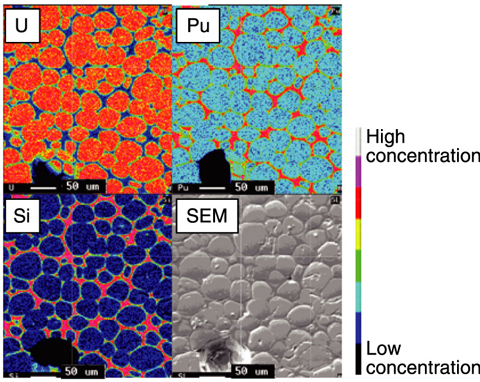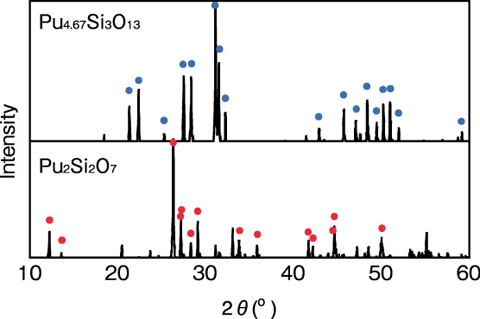
Fig.1-23 Element mapping images of MOX-6.9 wt%SiO2 analyzed by EPMA

Fig.1-24 X-ray diffraction patterns of PuO2-SiO2 mixed powders after annealing
Uranium and plutonium mixed oxide (MOX) fuels have been developed as fast reactor fuel. MOX fuels are fabricated from uranium dioxide (UO2) and MOX powders by a mechanical blending method. The mixed powder is pelletized and sintered. In the mixing process, there is a possibility that the MOX powder is contaminated with silicon (Si), which is used as part of the ball mill pot. Therefore, it is necessary to evaluate the behavior of Si impurity. In this study, phase states in MOX-SiO2 and PuO2-SiO2 systems were investigated to evaluate the behavior of Si in MOX fuels.
Specimens were prepared by mixing 6.9 wt% SiO2 powders with MOX, and pelletizing and sintering at 2400 °C. Fig.1-23 shows a cross-sectional mapping image of a pellet annealed at a low atmosphere (3.0 ×10-7 Pa) oxygen partial pressure (Po2). Because Pu and Si are enriched in the same area along grain boundaries, Si can be considered to have reacted with Pu and formed compounds.
PuO2-SiO2 reaction examinations were carried out to investigate the precipitation conditions and chemical forms of the compounds. Specimens were prepared by mixing powders of PuO2 and SiO2 in molar ratios of 3:1, 3:2 and 3:3, and were then annealed as a function of temperature (1350~1700 °C) and Po2 (10-7~10-10 Pa). X-ray diffraction patterns of the annealed specimens are shown in Fig.1-24. We observed that two kinds of compounds, Pu4.67Si3O13 and Pu2Si2O7, were formed as a function of temperature and Po2. The phase containing Pu2Si2O7 was precipitated in the specimens having mixing ratios of 3:2 and 3:3, and precipitation of Pu2Si2O7 was limited to the region above 1600 °C and a Po2 below 10-7 Pa. However, the Pu4.67Si3O13 phase was precipitated in more conditions in comparison to the Pu2Si2O7 phase. In addition to these two regions, there were conditions in which PuO2 and SiO2 compounds were not observed. These results show that, as a function of temperature and Po2, Si impurity in MOX forms three kinds of chemicals: SiO2, Pu4.67Si3O13 and Pu2Si2O7.
Thus, precipitation conditions for each compound were confirmed by investigating the behavior of Si impurity in MOX fuel. The acceptable level of Si impurity in MOX fuel is less than 1400 ppm, and the maximum amount of Si compound precipitated in MOX pellets is estimated to be less than 1 wt%. Therefore, Si impurity is considered to have a small effect on the properties of the fuel.